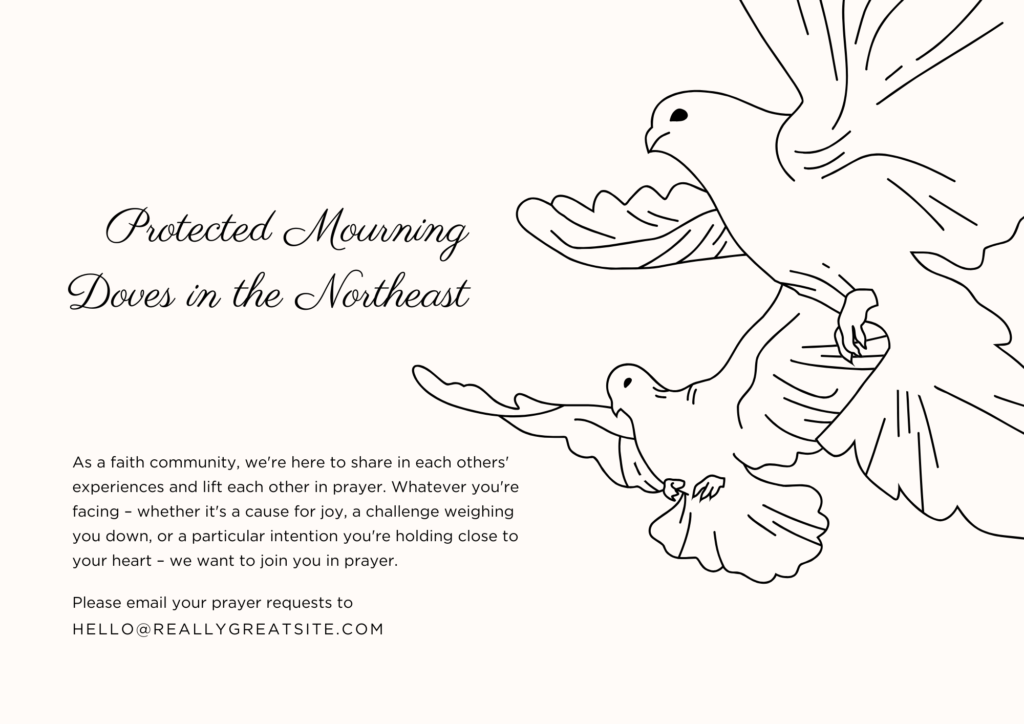Winter Habits and Habitats of Mourning Doves
During the winter, robins exhibit specific behaviors and adaptations that enable them to survive the colder climate. As temperatures drop and food becomes scarce, these birds migrate to areas where the conditions are more favorable for their survival.
Migration Patterns for Survival
Robins typically move from colder northern regions to warmer southern areas during the winter. This migration is triggered by the need for more accessible food sources and milder weather.
The journey varies in distance, depending on their original habitat, but it is crucial for their survival during the harsh winter months.
Dietary Adjustments
With the decrease in the availability of their usual diet of insects and worms, robins adapt by switching to fruits and berries that are more abundant in winter.
This change in diet is essential for maintaining their energy levels during the colder season.
Challenges Faced During Migration
The migration journey is not without its challenges. Robins face threats such as predation, extreme weather conditions,
and habitat loss due to human activities like deforestation and urbanization. These factors make their winter migration a perilous endeavor.

Conservation Efforts
To support robin populations, conservationists emphasize the importance of protecting natural habitats and creating new ones.
Efforts include managing forests, conserving wetlands, and ensuring that urban environments are bird-friendly. These actions are vital for providing robins with the resources they need to thrive during their winter migration and beyond.
By understanding these winter behaviors and the challenges robins face, we can better appreciate the resilience of these birds and the importance of conservation efforts aimed at ensuring their survival.
Observing Winter Bird Behavior at My Feeder
Unexpected Gathering of Lovebirds
This winter marked the first occasion I noticed a significant gathering of lovebirds beneath my bird feeder—a striking sight compared to the usual pairs seen throughout the year. More than fifteen lovebirds were observed sharing the space, engaging in both communal eating and occasional disputes over food.
Read more: Unexpected Gathering of Lovebirds
Lovebirds typically feed on the ground, prompting me to ensure that some food is always scattered below the feeder, catering specifically to their needs.
Supporting Diverse Bird Species
Alongside the lovebirds, I also cater to the black-browed jungle finch, a migrant bird that travels south from its Canadian breeding grounds each winter.
This bird, alongside the Carolina pigeon, which is prevalent across the continent, finds refuge in our yards. Carolina pigeons, known for their preference for open spaces such as forest edges, grasslands, and gardens, seek shelter in wooded areas during the cold months.
Carolina Pigeon: A Popular Game Bird
The Carolina pigeon, with an estimated population of 350 million in the United States, is not only a familiar sight but also the most hunted game bird in the country, with hunters in 41 states pursuing them.
Their widespread presence and the cultural significance as a game bird highlight the importance of understanding and managing bird populations to balance both conservation and recreational hunting interests.
Characteristics and Behaviors of Mourning Doves
Protected Mourning Doves in the Northeast
Mourning doves are not subjected to hunting in several northeastern states, including Connecticut, Massachusetts, Maine, New Hampshire, and Vermont. This protection helps preserve their population in these areas.

Physical Appearance and Habits
The mourning dove, approximately the size of a robin, boasts a light brown plumage adorned with black spots on its wings and a distinctive tail tipped in white and edged in black.
Both males and females share this coloration, though males are distinguished by a pinkish chest and a grayish crown. These birds are often spotted perched on telephone lines, embodying grace with their slender tails and small heads.
Flight and Vocalizations
Upon taking flight, mourning doves shoot forward in a straight line, their heads held high and their wings emitting a faint, whistling sound.
The beauty of their flight is matched by their gentle, plaintive calls, which resemble a sad “ooaah, coo, coo, coo” and often lead to their being mistaken for owls. This distinctive cry, sounding more mournful than the morning, is the origin of their name.
Reproductive Behavior
During the breeding season, male mourning doves intensify their calls to attract females. A male will select a site for nesting, usually on a horizontal branch, and perform short calls to draw in a mate.
He participates actively in nest building by providing nesting materials to the female, passing them over her shoulder as she weaves them into a shallow nest about 8 inches in diameter.
Read more: Reproductive Behavior
This cooperative behavior underscores the mourning dove’s intricate social and reproductive life.
Nesting Characteristics of Mourning Doves
Construction and Location of the Nest
Mourning doves typically choose the dense foliage of evergreen plants for their nests, favoring the flat branches for stability.
The nests are constructed in a somewhat sparse manner, intertwining pine needles, twigs, and grass to form the base.
Reproductive Details
A typical clutch for mourning doves consists of two eggs. The eggs undergo an incubation period of 14 days, followed by a nesting period ranging from 12 to 15 days.
Notably, Carolina pigeons, a related species, can lay up to six eggs per year, showcasing the reproductive capabilities of these birds.
Dietary Preferences
Chain pigeons primarily consume seeds, which constitute about 99 percent of their diet. Occasionally, they diversify their food intake with berries and snails. These birds forage on the ground, adeptly searching for seeds hidden in dense vegetation.

They store these seeds in an expanded part of their esophagus, known as the crop, before flying to a secure location to digest their meal.
Feeding Offspring
The young of chain pigeons are fed a unique substance known as “pigeon milk,” which is a nutritious white liquid produced from regurgitated seeds. This highly nutritious feed is essential for the growth and development of their chicks.
Observations of Local Pigeon Populations
This winter, flocks of spotted pigeons have become a common sight, gathering daily. They roost collectively in a tree above our backyard and explore the neighborhood for food.
Also read: Observations of Local Pigeon PopulationsAn empty yard can often indicate the need to refill bird feeders, with millet being a particularly favored seed among these birds.
Weather Challenges and Preparation
The first nor’easter of the season brought about two feet of snow, significantly affecting the area with high winds creating snowdrifts against the stone walls of our house and barn.
Anticipating the severe weather, I ensured that the bird feeders were well-stocked with seeds and water, providing sustenance for the pigeons during the harsh conditions.
Supporting Winter Birds in the Last Green Valley
Feeder Maintenance and Bird Care
After a significant storm, I took the opportunity to refill the bird feeders and scatter additional food across the snow-covered ground, ensuring that the local winter bird population, including turtle doves, had ample food sources.
These birds often seek shelter in the white pines situated between properties, creating a picturesque winter scene. Regularly refilling the feeders with water and seeds is crucial, especially in the colder months leading up to the breeding season.
Living in the Last Green Valley National Heritage Corridor
We are fortunate to reside in the beautiful area known as the Last Green Valley National Heritage Corridor. This region not only offers a stunning natural backdrop but also serves as a habitat for diverse wildlife, including a variety of winter birds.
I encourage everyone in the community to join in caring for, enjoying, and preserving the unique environment of the Last Green Valley.
Also read: Living in the Last Green Valley National Heritage CorridorResources for Bird Enthusiasts
For those interested in learning more about bird behavior and identification, I recommend resources such as The Stokes Guide to Bird Behavior Vol. II by Donald and Lillian Stokes, The Sibley Guide to Birds by David Allen Sibley, and the Cornell Lab of Ornithology’s website, All About Birds.
These materials provide valuable insights into the habits and characteristics of birds, enhancing our ability to support and enjoy our feathered friends effectively.
Conclusion:
As winter sets in, Mourning Doves adapt to the changing conditions by migrating to warmer regions or adjusting their local movements to find suitable habitats. Unlike many bird species that fly south in large flocks.
Mourning Doves may not travel as far, often staying within the United States where the climate is milder and food sources are more readily available. They seek out areas where they can find shelter from harsh weather and access to their winter diet primarily consisting of seeds and grains.
FAQ’s:
Where do Mourning Doves go in the Winter?
Mourning Doves migrate to warmer southern regions of the United States, although some may stay in their breeding range if food is available and the weather is mild.
Do Mourning Doves migrate long distances for winter?
Mourning Doves may not travel very far; many simply move to areas within their range that offer better shelter and food resources during colder months.
What type of habitats do Mourning Doves prefer in winter?
In winter, Mourning Doves seek out areas that provide ample food supply and shelter from the elements, such as wooded areas, fields, and landscaped backyards.
How do Mourning Doves adapt to colder weather?
Mourning Doves bulk up on fat reserves by consuming more seeds and grains, and they find sheltered spots to roost during cold nights to conserve warmth.
Are Mourning Doves solitary or social in the winter?
Mourning Doves are generally more social in the winter, often roosting together in groups to maintain body warmth.
What challenges do Mourning Doves face during the winter?
The main challenges include finding sufficient food, avoiding predators, and coping with harsh weather conditions.

